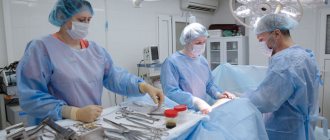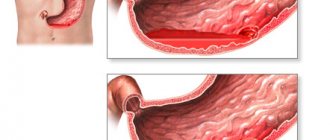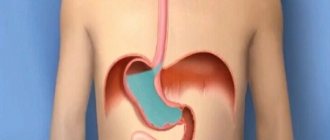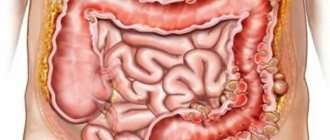Most methods of combating excess weight are based on restricting diet and increasing physical activity. But in severe cases of obesity, gastric resection may be prescribed. This is a radical measure that is carried out in exceptional cases and has a number of nuances.
The information presented here is of interest from a purely educational point of view. It cannot be used to decide whether a particular case requires resection or not. Only a doctor can determine this.
What is gastric resection, the essence of the operation
Gastric resection was initially used only to treat certain diseases of the gastrointestinal tract. It involves partial cutting off or complete removal of the stomach. This can be longitudinal removal or using the Balfour method. After such an operation, the functionality of the gastrointestinal tract is restored. Not so long ago, this kind of intervention was used only when all other methods of treatment had been exhausted and the person was in danger of dying. But recently, resection has been prescribed for the treatment of terminal obesity.
As a result of the operation, half, a third or a quarter of the stomach may be removed. Sometimes subtotal resection is used, in which 80% of the organ is removed. The size of the removed part depends on the level of obesity. After rehabilitation, a person adapts to living with a reduced stomach. It takes less food to fill it, so the portions become noticeably smaller. As a result, the number of calories consumed is reduced, and the patient begins to lose weight.
But that is not all. It is very important to eat right after surgery. You need a balanced, well-thought-out diet. If you improve your diet, your weight will gradually become satisfactory.
Benefits of the procedure
Distal gastrectomy allows you to achieve truly impressive results. In just six months or a year after it, people lose from 50 to 90% of excess weight. The rehabilitation course is very short, patients quickly return to normal life, since minimal incisions are made during the operation, and the scars are very small.
During the resection process, only the stomach is affected. The remaining organs of the gastrointestinal tract continue to work. The operation is performed once. Repeated interventions or corrective procedures are usually not required. The remaining part of the stomach will forever retain its new size, so satiety will occur with less food consumption.
Restrictions
Monitor sun exposure after stomach cancer removal
As a rule, restrictions for patients are temporary. Such people are prohibited from physical therapy and visits to the solarium. Regulate exposure to the sun; heat loads in the form of a sauna or steam bath are also undesirable. Such actions can cause the appearance of metastases.
Women after this operation (especially due to cancer) are not recommended to become pregnant for 3-4 years. Since this is a lot of stress and a number of physiological changes for a woman, they can affect her health and lead to the recurrence of cancer.
Flaws
This operation has its negative consequences. For example, after excision the stomach has reduced peristalsis; a person with a reduced organ may face the problem of intestinal obstruction. When a staple seam is performed incorrectly, inflammatory and infectious processes sometimes occur. Therefore, it is very important to be observed by a doctor during the postoperative period.
Gastric truncation is an irreversible procedure. Having made a resection once, it is no longer possible to return the organ to its original state. Sometimes a hernia forms at the sites of micro-incisions and sutures.
The first six months after surgery undergoes a process of adaptation of the body. During this time, such phenomena as constipation, diarrhea, and flatulence are common. There are side effects that do not go away even after the end of the adaptation period - heartburn, spleen diseases, stomach bleeding, inflammation of the abdominal cavity. If you look at the reviews, you can see that all sorts of complications of this kind are not uncommon.
Among other things, the passage of solid food with an excised stomach will be difficult. The first time after the procedure, abdominal pain appears when eating solid food. Over time, the pain goes away, but mild discomfort may remain.
Prevention
The main preventive measure is strict food restriction. Eliminate foods from your diet that maximize bile secretion. Since the body cannot carry out its functions sufficiently, chew your food thoroughly.
The main requirements for therapeutic nutrition are:
- a sufficient amount of proteins, carbohydrates, vitamins A, B, C;
- warm food (neither hot nor cold);
- lack of table salt.
Life after gastric surgery can be fulfilling. The main thing is to go through the recovery period correctly. To do this, follow all the requirements and prescriptions of your doctor, follow a diet, and avoid physical activity. Surround yourself with pleasant emotions and a positive attitude, this is the only way you can return to your previous lifestyle.
We recommend reading: esophageal vein ligation
Comparison of the method with other methods of stomach reduction
There are several other surgical methods to reduce the absorptive surface of the stomach. Each of them has its own characteristics and is prescribed for certain indications.
Ballooning
With this technique, a silicone bladder is inserted into the stomach, which is then filled with saline solution. Being inside the stomach, the bubble creates a feeling of fullness, as a result of which a person eats much less. After it is performed, the patient can immediately go home, and after resection, he must spend at least 3 days in the hospital. But ballooning ensures a loss of only 40% of excess weight, and resection – from 50 to 90.
Ballooning is a fairly simple medical procedure that does not involve surgery. During the first days after the procedure, nausea and vomiting are possible. But these complications are not nearly as serious as the possible consequences after organ truncation surgery.
After 6 months, the balloon should be removed. During this time, a person, theoretically, should get used to small portions. But if he resumes his previous eating habits, the weight will increase again. Another nuance is that sometimes the balloons burst right inside the stomach. This can happen without a person noticing. Therefore, the saline solution with which it is filled is colored blue. If the balloon suddenly bursts, the saline solution will turn the urine blue, and the patient will see this the first time he urinates. Blue urine for people with ballooning is a signal to urgently go to the doctor and remove the balloon.
Bandaging
This procedure involves placing a bandage – a silicone ring – on the stomach. The ring compresses the stomach, dividing it into two parts. At the site of compression, a gap as thick as the esophagus is left. The upper part of the stomach turns out to be very small. Food goes into it first. It fills quickly and signals that saturation has occurred. Then gradually the food moves to the lower part of the stomach, and then to the small intestine.
After the bandage, the person spends one day in the hospital. The procedure allows you to lose up to 50% of excess weight. Banding is performed using a minimally invasive method, which is much easier for the patient than a full-fledged surgical intervention such as resection. Complications with banding are the same as in other cases when a foreign body is placed inside.
Gastroplication
This is a method in which the stomach is folded in its expanded part and sutured in a special way, after which it takes the shape of a tube. It is performed laparoscopically, without organ incisions. Provides loss from 35 to 50% of excess weight. After the procedure, you may have problems eating. Long-term results have not yet been studied, as the technique has only recently become widely used.
Bypass surgery
During bypass surgery, a small part of the stomach is separated from the main one and connected to the small intestine in a bypass. After the procedure, the capacity of the working part of the stomach is reduced, and the degree of absorption of nutrients decreases. Bypass surgery is an even more complex surgical operation than resection. After it, patients remain under the supervision of doctors even longer.
The result of bypass surgery is a loss of 70 to 80% of excess weight. But quite serious complications can arise in the form of insufficient absorption of microelements and vitamins. Vomiting and nausea often occur.
In this case, the weight comes off within a year or two. After this, the person’s condition stabilizes, and if one does not return to harmful eating habits, the slim figure is maintained. If necessary, you can restore the original shape of the stomach.
Diet after surgery
After surgery, it is important to monitor your body weight and report changes to your doctor.
Nutrition after gastrectomy is as important a part of treatment as the surgery itself. The main principle of this diet is to eat pureed, soft food, without any substances that can irritate the mucous membrane of the gastric stump and cause anastomositis. Also, food intake is prescribed in small portions and fractionally (5-6 times a day) in order to reduce the filling of the duodenum and prevent the development of afferent loop syndrome or dumping syndrome.
It is strictly forbidden to consume all alcoholic, caffeinated or carbonated drinks, fatty, fried, salty or spicy foods. It is recommended to eat food cooked exclusively by steaming. Very similar to this diet is the diet after removal of the stomach, which also serves the function of sparing the damaged gastric mucosa. Diet during gastrectomy for cancer is also similar to the diet for gastrectomy and peptic ulcer disease.
Advice: after surgery, many patients wonder how to live after removal of the stomach, since the lifestyle and diet in this condition is different from the usual. The inability to eat the usual food can lead the patient to depression. Therefore, in the first weeks and months after resection, it is necessary to conduct conversations with the patient to provide support, education and control of diet.
Gastric resection is a fairly effective method in the treatment of conditions such as cancer, multiple gastric ulcers, as well as in the fight against obesity (sleeve gastrectomy). This operation is highly traumatic, which, however, is less than with many other surgical interventions (for example, liver resection). The prognosis after this method of surgical therapy is still more favorable, since in almost 90% of all cases the intervention has a positive effect, and complications account for only 10%.
We recommend reading: gastric biopsy using endoscopy
Indications for resection
Gastric resection is indicated for complex obesity, which is accompanied by severe pathologies:
- metabolic syndrome;
- apnea (short-term cessation of breathing during sleep);
- pulmonary or heart failure;
- joint diseases;
- phlebeurysm;
- hypertension;
- infertility;
- diabetes.
The appointment is made taking into account the fact that excess weight has already led to concomitant diseases, and can further aggravate the person’s condition, as well as the fact that the person himself is no longer able to get rid of obesity in more natural ways. It is also clarified that the procedure allows you to remove no more than 50 kilograms.
Contraindications to gastric resection
It is immediately worth noting that obese people, as a rule, have a whole bunch of diseases, and some of them are a contraindication to resection. Therefore, patients who are ready to go under the surgeon’s knife and pay a lot of money for it are often denied the operation.
Contraindications:
- autoimmune connective tissue diseases;
- taking hormonal steroid drugs on a regular basis;
- age under 18 years;
- alcoholism;
- kidney diseases;
- psychical deviations;
- chronic gastrointestinal diseases;
- ascites.
The procedure cannot be performed if there are inflammatory processes in any organs. Among other things, the anesthesiologist must give permission for the operation, since it is performed under general anesthesia. Therefore, one should also take into account contraindications to anesthesia, and this is a whole range of cardiovascular, pulmonary and other diseases that often affect obese people.









